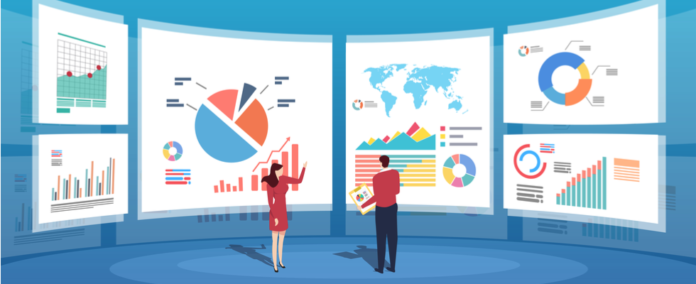If you have a dilemma about whether you should opt for a business or data analyst role, then you have arrived at the right place. In this blog, you will get to know all about the sectors, the job roles, the salary, and much more. Apart from this, visiting this site would be quite helpful if you need any guidance on Career Profiles.
If the estimates are accurate, then around 70,000 search queries are carried out on Google every second. As you can imagine, there is just an enormous amount of data that requires thorough investigation and comprehension. Companies use these data to get insight into the different processes and make decisions. And this is where a data or a business analyst comes in handy.
Let us explore the domains first.
Business Analytics
Business analytics (BA) is the process of iteratively exploring an organization’s data, with a focus on using statistical analytical tools. This helps to uncover insights that can drive innovation and financial performance. Big data is treated as a valuable corporate asset by analytics-driven companies, who use it to fuel company planning and support future plans.
There exist three types of business analytics. These are:
- Descriptive Analytics
This sort of analytics examines previous data in order to gain insight into future planning. Executives and non-technical workers can profit from big data insights to improve business performance thanks to the broad availability of self-service data access and discovery tools and dashboards.
- Predictive Analytics
The next step on the road to insight is predictive analytics. It helps organizations predict the possibility of future events using machine learning and statistical methodologies. However, predictive analytics is probabilistic; it can only recommend the most likely conclusion based on past events.
- Prescriptive Analytics
Prescriptive analytics looks into possible actions based on descriptive and predictive analytical results. This sort of analytics mixes mathematical models and business principles to help people make better decisions by suggesting many options for different scenarios and trade-offs.
Now, we will take a look at what Business analysts have to do on a daily basis.
What do Business Analysts do?
Business analysts assist their organizations in identifying challenges, opportunities, and solutions. They accomplish this by:
- Assessing the current roles and IT structures of an organization
- Developing graphics and financial models to aid corporate decision-making
- New system training and coaching
- Evaluating processes and interviewing team members to identify areas for improvement
- Submitting recommendations and findings to senior members and stakeholders
Next, we will assess the Data Analytics process.
Data Analytics
The process of gathering and analyzing raw data in order to develop conclusions about it is known as data analytics. Every company gathers vast amounts of data, whether it’s sales figures, market research, logistics, or transactional data.
The true value of data analysis resides in its capacity to spot trends, hazards, and opportunities in a dataset. Businesses can use data analytics to make better decisions by modifying their processes depending on what they’ve learned. This could entail determining what new products to introduce in the market, devising tactics to keep key clients, and so on.
Data analysts can sort out the huge amount of data via:
- Data mining is the process of sifting through massive data sets in order to find trends, patterns, and connections.
- Predictive analytics gathers and analyses historical data to assist firms in responding properly to future events such as customer behavior and equipment problems.
- Machine learning is a technique for teaching computers to process data more quickly than traditional analytical modeling.
- Data mining, predictive analytics, and machine learning methods are used in big data analytics to translate data into business intelligence.
- Text mining is a technique for detecting patterns and attitudes in papers, emails, and other text-based content.
Now, we will see what the job description of a data analyst is.
What do Data Analysts do?
To assist in making business decisions, data analysts collect, clean, analyze, visualize, and present existing data. An effective data analyst analyses data to answer a question and empower decision-makers to choose the best path forward. A data analyst’s typical responsibilities include:
- Defining a problem or a business requirement with the help of business leaders and stakeholders
- Locating and obtaining data
- Data cleaning and preparation for analysis
- Assessing data for trends and patterns
- Making data more understandable by displaying it in a visual format.
- Presenting data in a manner that it can be comprehended easily.
Following this, we will check out the degree requirements.
What Qualifications are Required?
Although most firms prefer applicants with at least a bachelor’s degree, business and data analysts can come from a range of academic backgrounds. Business analysts typically have a bachelor’s degree in a business-related discipline. On the contrary, data analysts typically have a bachelor’s degree in a STEM field such as statistics, math, or computer science.
However, if one gets a master’s degree and a few years of experience, internships, then he or she can expect a lot of opportunities. And, you can also look for job openings at reputed firms that too at higher positions.
Meanwhile, if you are struggling with management, programming or mathematical problems, you should seek assignment help from professional experts.
What is the Salary Status Quo?
Both data and business analysts are in high demand and well compensated. Your best decision will be determined by your specific interests, talents, and professional objectives. A data analyst profession can be a good fit for you if you have a strong interest in mathematics and statistics. Consider business analytics instead if you’re more of a problem solver with a business mindset.
Speaking of salary, a data analyst can earn between $47k-$113k, with an average of $66,906.On the other hand, business analysts earn around $73,913 in the US (Glassdoor, 2021). It also depends on the designation and job openings.
Are the Job Roles Interchangeable?
Data analysts can advance to the position of a business analyst (and vice versa). Many of the abilities are similar. A data analyst transitioning into business analytics should brush up on their understanding of company architecture and process prototypes. SQL, statistical programming, and data management abilities can be developed by business analysts who want to deal more closely with data sets.
Career Growth in Both Domain
From the smallest start ups to the largest multinational corporations, every company uses data to drive innovation and commercial growth. The goals of data analytics and business analytics are similar in that they both aim to optimize data to increase efficiency and solve problems. And technologies are at the grassroot level. So, you can only imagine how significant the job roles will become in ten years.
Hopefully, you have some insight into the whole business and data analysts’ role. So, it is wise that you take your subjects seriously and start putting in more effort. And if you have any confusion regarding statistics, or algorithm, you should seek math homework help from professional experts.
Author Bio: Bradley Harper is a data science expert, and he has been associated with a number of projects over the year. He is also an avid blogger, and he shares valuable insight into the skills required today. Currently, he also supervises chemical engineering assignment help service at MyAssignmenthelp.com.
























